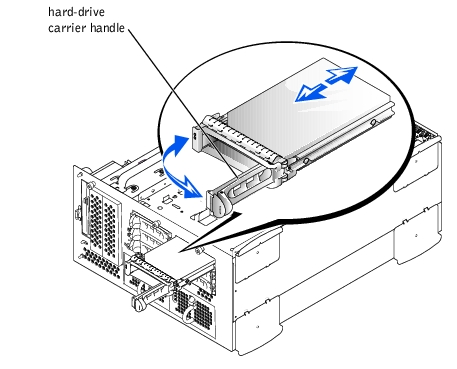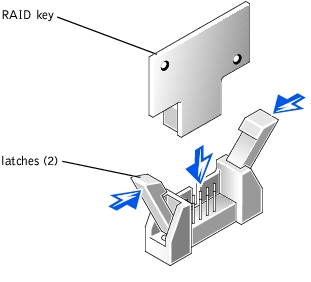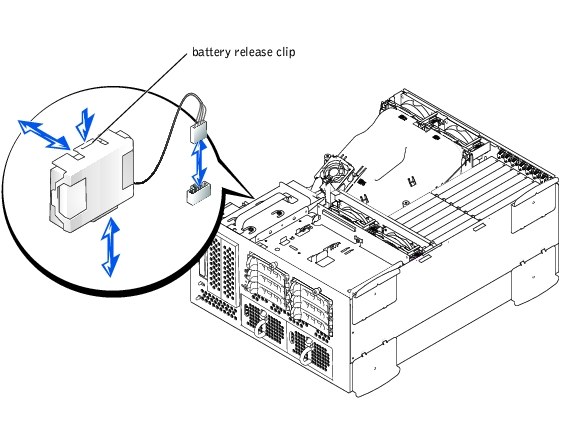 Before You Begin
Before You BeginDell™ PowerEdge™ 2600 Systems Installation and Troubleshooting Guide
 Installing an External SCSI Tape Drive
Installing an External SCSI Tape Drive
 Activating the Integrated RAID Controller
Activating the Integrated RAID Controller
 Installing a RAID Controller Card
Installing a RAID Controller Card
 Installing a SCSI Backplane Daughter Card
Installing a SCSI Backplane Daughter Card
Your system features an internal drive bay that contains up to six 1-inch hard drives. Your system also features a removable peripheral bay that incorporates two drive bays for installing two additional hard drives or an internal tape drive. Attached to the removable periperal bay is a user-assessable, half-height, CD drive and a 3.5-inch diskette drive, which is controlled by the IDE/diskette drive controller on the system board.
This section contains instructions for:
Hard drives are supplied in special drive carriers that fit in the hard-drive bays.
 |
NOTICE: Before attempting to remove or install a drive while the system is running, see the documentation for the host adapter to ensure that the host adapter is configured correctly to support hot-pluggable drive removal and insertion. |
 |
NOTICE: Do not turn off or reboot your system while the drive is being formatted. Doing so can cause a drive failure. |
 |
NOTE: Only use drives that have been tested and approved for use with the SCSI backplane board. |
When you format a high-capacity hard drive, allow enough time for the formatting to be completed. Long format times for these drives are normal. For example, an exceptionally large drive can take over an hour to format.
After the SCSI devices are installed, install and configure any SCSI device drivers to enable them to communicate with your operating system.
SCSI device drivers are provided for the following operating systems:
See "Using the Dell OpenManage Server Assistant CD" in the User's Guide for instructions on creating a diskette of drivers for your operating system. For instructions on configuring the SCSI device drivers, see the documentation that came with your operating system.
The hard-drive bays provide space for up to six 1-inch hard drives. The hard drives connect to a controller on the system board or a RAID controller card through the SCSI backplane board.
The system provides several options for hard drive configurations:
See Figure A-4 to locate the connectors on the SCSI backplane board.
 |
NOTICE: Not all operating systems support hot-plug drive installation. See the documentation supplied with your operating system. |
If the drive has been online, the drive status indicator will blink green two times a second as the drive is powered down. When all indicators are off, the drive is ready for removal.
See your operating system documentation for more information on taking the hard drive offline.
Figure 7-1. Removing and Installing a Hard-Drive

If you are permanently removing the hard drive, install a blank insert.
 |
NOTICE: When installing a hard drive, ensure that the adjacent drives are fully installed. Inserting a hard-drive carrier and attempting to lock its handle next to a partially installed carrier can damage the partially installed carrier's shield spring and make it unusable. |
 |
NOTICE: Not all operating systems support hot-plug drive installation. See the documentation supplied with your operating system. |
 |
NOTICE: Do not insert a hard-drive carrier and attempt to lock its handle next to a partially installed carrier. Doing so can damage the partially installed carrier's shield spring and make it unusable. Ensure that the adjacent drive carrier is fully installed. |
This section describes how to configure and install an external SCSI tape drive.
You must connect external SCSI devices to a SCSI host adapter expansion card. See "Expansion Cards" in "Installing System Options" for information about installing expansion cards.
SCSI interface connectors are keyed for correct insertion. Keying ensures that the pin-1 wire in the cable connects to pin 1 in the connectors on both ends.
When you disconnect an interface cable, take care to grasp the cable connector, rather than the cable itself, to avoid stress on the cable.
Although SCSI devices are installed in essentially the same way as other devices, their configuration requirements are different. To configure an external SCSI device, follow the guidelines in the following subsections.
Each device attached to a SCSI host adapter must have a unique SCSI ID number from 0 to 15.
A SCSI tape drive is configured by default as SCSI ID 6.
 |
NOTE: No requirement exists that SCSI ID numbers be assigned sequentially or that devices be attached to the cable in order by ID number. |
SCSI logic requires that termination be enabled for the two devices at opposite ends of the SCSI chain and disabled for all devices in between. For internal SCSI devices, termination is configured automatically. For external SCSI devices, you should disable termination on all devices and use terminated cables. See the documentation provided with any optional SCSI device you purchase for information on disabling termination.

|
CAUTION: See "Protecting Against Electrostatic Discharge" in the safety instructions in your System Information document. |
Ground yourself by touching an unpainted metal surface on the back of the system, unpack the drive (and controller card, if applicable), and compare the jumper and switch settings with those in the drive documentation.
See "SCSI Configuration Information," for information on setting the drive's SCSI ID number and enabling termination (if required). Change any settings necessary for your system's configuration.

|
CAUTION: Replace the battery only with the same or equivalent type recommended by the manufacturer. Discard used batteries according to the manufacturer's instructions. See the System Information document for additional information. |

|
CAUTION: Before you perform this procedure, you must turn off the system and disconnect it from its power source. For more information, see "Safety First—For You and Your System" in "Troubleshooting Your System." |

|
CAUTION: See "Protecting Against Electrostatic Discharge" in the safety instructions in your System Information document. |
 |
NOTICE: To avoid possible data loss, back up all data on the hard drives before changing the mode of operation of the integrated SCSI controller from SCSI to RAID. |
See Figure A-3 to locate the RAID memory module connector on the system board.
The memory module connector has two alignment keys that allow the memory module to be installed in the connector in only one way.
 |
NOTE: The RAID controller memory module must be an unbuffered memory module, rated to run at 100 MHz or faster. Do not substitute registered memory modules such as those used for system memory. |
Figure 7-2. Installing the RAID Controller Memory Module

See Figure A-3 to locate the RAID hardware key on the system board.
Figure 7-3. Installing the RAID Hardware Key

See Figure A-3 to locate the RAID battery cable connector on the system board.
Figure 7-4. Removing and Installing the RAID Battery

See the RAID controller documentation for more information.
Follow these general guidelines when installing a RAID controller card. For specific instructions, see the documentation supplied with the RAID controller card.

|
CAUTION: Before you perform this procedure, you must turn off the system and disconnect it from its power source. For more information, see "Safety First—For You and Your System" in "Troubleshooting Your System." |

|
CAUTION: See "Protecting Against Electrostatic Discharge" in the safety instructions in your System Information document. |
For instructions, see the documentation accompanying the card.
 |
NOTE: Cables can be connected from the RAID controller card to SCSI A and/or SCSI B backplane board connector(s). A backplane board connector that is not attached to the RAID controller card will use the onboard SCSI controller or optional integrated RAID controller. |
To identify the connector on the RAID controller card, see documentation for the card. See Figure A-4 to locate the SCSI controller connectors on the SCSI backplane board.
Route the SCSI cables around the expansion-card guide and under the front fan assembly to reach the RAID controller card.
If you are attaching multiple external SCSI devices, daisy-chain the devices to each other using the cables shipped with each device.
Test a SCSI hard drive by running the SCSI Controllers test in the system diagnostics.
To operate the SCSI backplane in a 2 x 3 split backplane configuration, you must install a daughter card.

|
CAUTION: Before you perform this procedure, you must turn off the system and disconnect it from its power source. For more information, see "Safety First—For You and Your System" in "Troubleshooting Your System." |

|
CAUTION: See "Protecting Against Electrostatic Discharge" in the safety instructions in your System Information document. |
Figure 7-5. Installing a SCSI Backplane Daughter Card

See Figure A-4 to locate the connectors on the SCSI backplane board.
If you plan to boot the system from a hard drive, the drive must be attached to the primary (or boot) controller. The device that the system boots from is determined by the boot order specified in the System Setup program.
The System Setup program provides options that the system uses to scan for installed boot devices. See your system's User's Guide for information about the System Setup program.